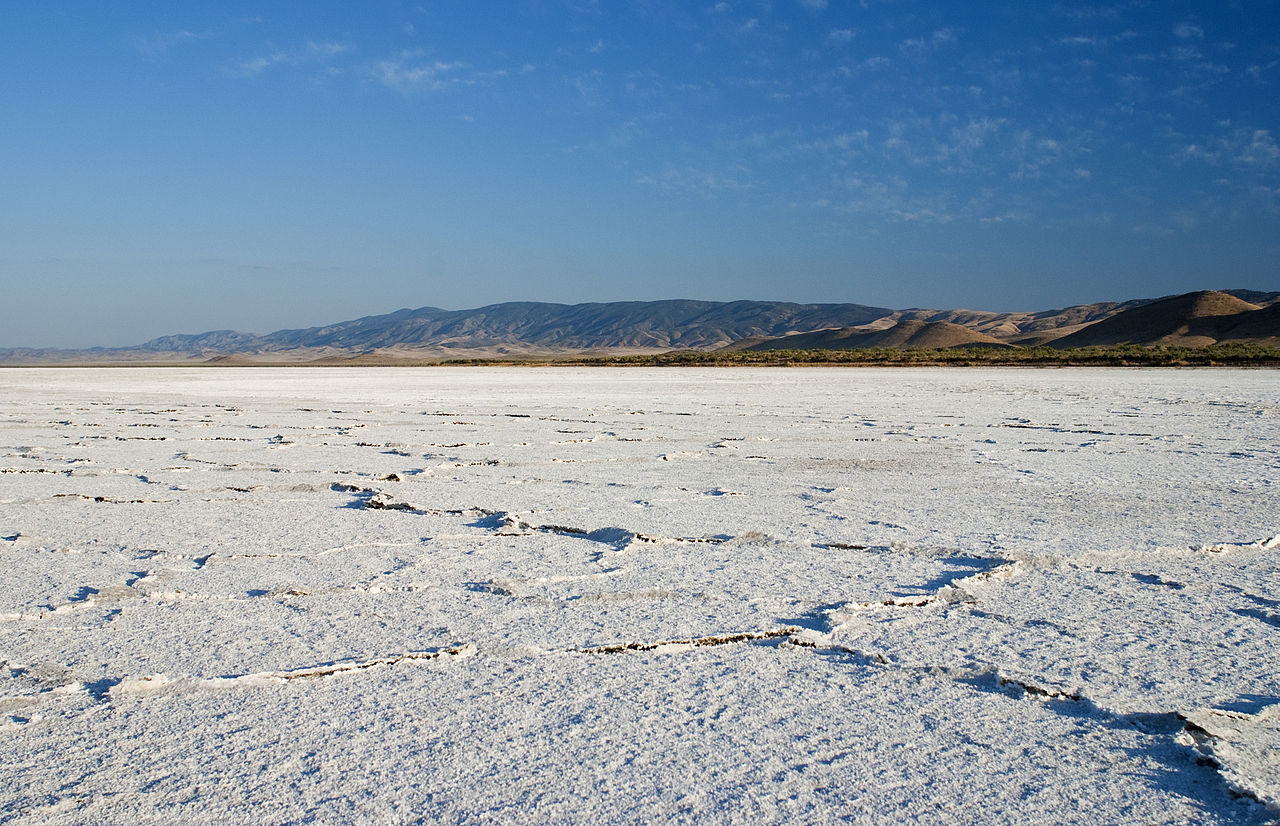What is a rock?
A purely descriptive definition is that a rock is - A naturally occurring aggregate of minerals and other solid material. - Usually, there are several minerals in the aggregate, though some rocks may have only one. The other materials may include natural glasses, organic material, or fossils.
Geologists usually think of rocks in a second important way, however. Please and recite it like a mantra:
A rock is a record of the environment in which it formed.
Major Rock Types:
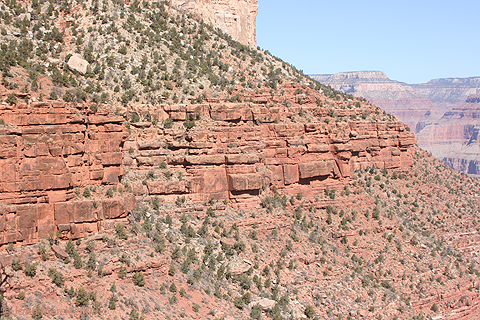
Supai group of the Grand Canyon

Gas bubbles through lava flow - Santiago Island, Galápagos Islands

Ortega Quartzite, near Taos, NM - pressure-cooked sandstone
What kind of information do these rocks give us about past environments?
Igneous Rocks: Rocks from Earth's Interior
Visible features of igneous rocks tell us about:
- Where they solidified
- If they erupted, how they erupted
Where they cooled:
- Intrusive igneous rocks: Cooled and solidify slowly beneath the surface, allowing them plenty of time for form big visible crystals. We only see them because they are unearthed by erosion. Other rock types have big crystals, but intrusive rocks' crystals are:
- Large and interlocking
- Have no preferred orientation - i.e. a piece of intrusive rock looks more or less the same no matter which way you turn it.

Santiago Island basalt cooled quickly at the surface. - Extrusive igneous rocks: are igneous rock that cooled quickly from magma that has erupted onto the Earth's surface. Their crystals might be:
- Tiny
- Nonexistent
- Like with all igneous rocks, crystals have no preferred orientation.

Yosemite granite cooled slowly underground, and brought a piece of Earth's deep crust up with it.
How they erupted: Some magma (molten rock) is "dry" with very little dissolved water vapor, and some is "wet" with lots of it. How magmas erupt depends largely on this variable:
- dry magma: Usually erupts as a fluid that flows downhill and solidifies as a lava flow

Welded tuff in the Chiricahua Mts., AZ - Wet magma: Erupts explosively as gasses bubble out of solution during an eruption faster than the magma can move out of the way. The magma shatters into volcanic ash - an aerosol of fine particles. Often, ash fragments are still slightly sticky when they fall, sticking together to form welded tuff that can be soft and powdery.
The magic is that even igneous rocks with the same composition look different depending on how and where they solidified. For example:
all have the same composition.Note: Igneous rocks do vary in composition. Color is often a good way to approximate their chemistry, but we are not so worried about that here. Example: Granite and gabbro have similar crystal sizes and cooling histories but are chemically different.

Fresh lava flows from Ke Ala Komo Overlook, HI
Beyond this, igneous rocks can tell us:
- How long ago they formed: They are the easiest rocks to date using the decay of radioactive isotopes.
- What Earth's magnetic field was like when they formed: Some minerals in igneous rocks align to Earth's magnetic field when they solidify, creating a snapshot of the field's direction and polarity when the rock cooled.
Metamorphic Rocks: Cooked, but by a variety of chefs
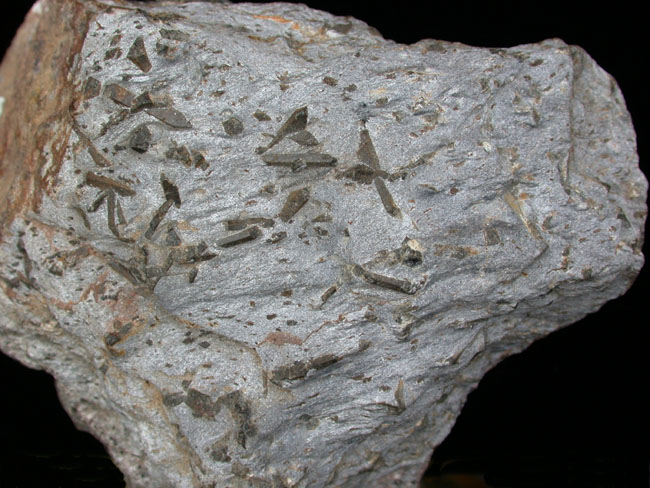

Before................................................................After
Metamorphic rocks are rocks that have been transformed by heating and compression in a solid state - cooked, in effect. Heat and compression can cause chemical reactions that allow new mineral grains to grow inside an existing rock, as its ions reorganize. The result is a new rock made of the same atoms as the old one, but containing a different suite of minerals.
Metamorphic rocks are complex but even to the rank amateur, there is one obvious message that they often convey: Compression in a single direction. This frequently results in the formation of platy minerals like micas, whose grains are aligned parallel to one another and perpendicular to the direction of pressure. Viewed from above, they look shiny and reflective (above). From the side, they look like pages of a book. For this reason, the texture is called foliation. Note: foliation planes start out planar but are often, themselves, folded by later compression.
But what is foliation a record of? What event compresses rocks in a single direction? Answer: Continental collisions caused by plate tectonics.
Sedimentary Rocks: Rocks from Earth's Surface

Sedimentation in microcosm on Venice Beach, Los Angeles, CA
- Clasts: Physical fragments of preexisting rock (clay, silt, sand, pebbles, boulders, etc.)
- Ions in solution
General life history of sediment: In order to make a sedimentary rock, four things need to happen:
- Weathering: The physical and chemical reduction of preexisting rock
- Transport: running water, gravity, ice, wind. Material may be transported as fragments or in solution.
- Deposition: The process of depositing the sediment. For materials in solution, this involves precipitation.
- Cementation: The binding of grains through the precipitation of mineral cements (or, sometimes, through chemical reactions between the grains, themselves, that cause them to bind).
- What agent of transport moved the sediment
- How much energy it had
- How far sediments were carried
- What kind of environment they were deposited in
- What living things were present in the environment
- What global environments were like when the sediments were deposited.
What agent moved the sediment?
- Gravity: Wherever there is a topographic slope, there is the potential for loose material to slide down it under the influence of gravity. Gravity usually only moves sediments short distances so clasts tend to be:
- Angular (poorly rounded)
- Poorly sorted (a wide range of sizes)

Savage River, Denali National Park, AK. - Streams and rivers: On the continents, the primary movers of sediment are flowing streams and rivers. These deliver their sediment load to the shores of standing bodies of water like lakes and oceans but not far into them. Thus, a common depositional feature is the delta, a fan of sediment deposited at a river mouth. Stream-transported sediment may travel long distances so it tends to be:
- Well rounded
- Size-sorted by hydrodynamic processes on a small scale. (Different parts of a stream can treat sediments differently, so in one place, it may deposit gravel and pebbles and in another, mud.

Oblique waves power long-shore current between Smithfield and Port Douglas, QLD. - Waves: Where the interface of air and water meets the shore, wave energy transports sediment along the shoreline. Waves usually transport sand-sized grains so their sediments are:
- Well sorted by size (sand)
- Reasonably well-rounded

Sediments deposited at toe of Matanuska Glacier, AK - Glacial ice: The ultimate, indiscriminant mover of sediment fragments of all sizes. Glaciers treat all clast sizes the same, and push and carry clasts rather than rolling them, so glacial sediments are usually:
- Supremely poorly sorted
- Angular
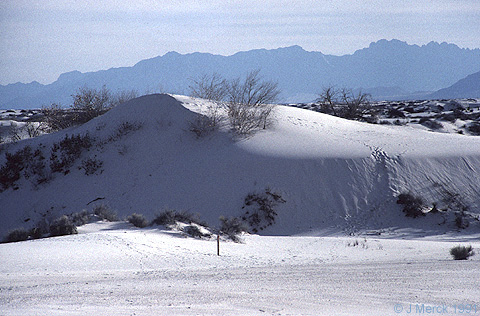
White Sands, NM - Aeolian transport: The wind is major transporter of small fragments. On Earth, it lofts dust-sized particles far into the atmosphere and bounces sand grains along the surface, where they can collect in dune seas if they encounter some kind of topographic trap. Wind-driven sediments are:
- Supremely well sorted
- Extremely rounded
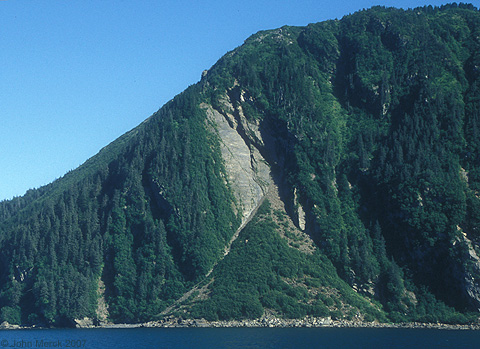
Landslide scar and deposit at Resurrection Bay, AK.
- The source rock from which sediments were weathered.
- How far and by what means they were transported: Different agents of transport favor different grain sizes and modifies those grains in different ways. E.G.:
- Sorting: The wind strongly sorts sediment grains by size. Glaciers don't discriminate between grains of dust and boulders the size of houses.
- Rounding: Stream and shoreline sediments, having been rolled for long distances over a solid surface tend to be rounded and polished. Aeolian sediments are "frosted" by sand-blasting. Gravity and glacier-transported sediments may be angular.

Sediment carried by Matanuska Glacier, AK
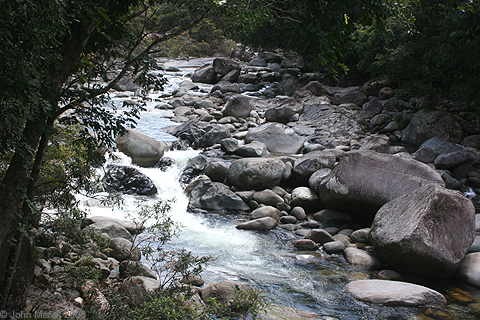
Mossman River, Queensland - How much kinetic energy the agent of transport possessed. EG:
- Some streams (E.G. the Toklat River in Alaska) flow so fast that they can move boulders during full flood and only deposit finer sediments like sand and mud during low flow. The sediments they deposit may contain large amounts of coarser clasts.
- Some (E.G. the tidal stretches of the Potomac) flow so slowly that fine clay-sized particles are the only things they can move. Their deposits would be fine grained.
All of this allows us to identify the the kind of environment they were deposited, as each depositional environment has characteristic fingerprints. E.G.:
- Flowing currents: these move sediments in piles called bedforms that can take the form of:
- asymmetric ripples,
- subaqueous dunes (right)
- (if moved by air) subaerial dunes.
When bedforms are transformed into sedimentary rocks, they record their identity.
- Wind deposit environments are marked by large "cross-beds" that preserve the ancient slip-faces of sand dunes.
- Ancient stream environments also preserve much smaller cross beds.

Wave ripples in Moenkopi Sandstone, Wupatki National Monument, AZ - Waves: What if sediments are deposited on a shoreline with oscillating waves? In that case we can see symmetrical ripple marks.
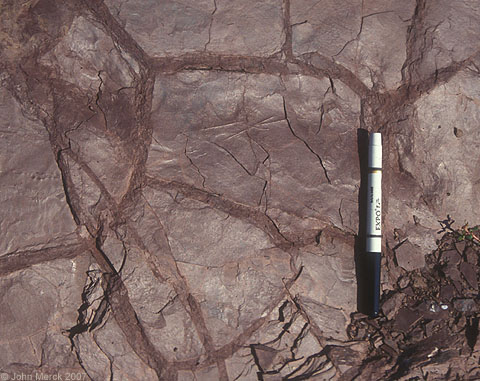
Mud cracks in Gettysburg Formation, Rocky Ridge, MD - Subaerial exposure: What if sediments are deposited by water but exposed to air? In that case we see features like
- Mud cracks (right)
- Raindrop casts
- Trackways
Frequently, sediment is transported as ions dissolved in solution. In some settings, these precipitate out:
- The beds of ephemeral lakes and other restricted bodies of water are preserved as crusts of minerals precipitated from solution. (right) Common examples include gypsum, halite (rock salt) and sylvite.
- Or as coatings of precipitates over grains.

Pleistocene coral reef rock, Quintana Roo, Mexico
Precipitated first in the tissues of organisms, then deposited when the organism dies. E.G.
- limestone - calcite from the shells of marine organisms. Indeed, modern coral reefs are limestone factories, and have their counterparts in the past.
- coal - carbon from compressed remains of land plants.
Even when the remains of critters don't make up the bulk of the rock, sedimentary rocks form where life lives, so they often contain fossil remains of the critters that inhabited the depositional environments.

1000 year old Sunset Crater basalt above
240 million year old Moenkopi Formation sandstone, AZ
More! More!
This is only the beginning of what rocks tell geologists about the ancient Earth. By compiling information about the condition where specific rocks formed, we can reconstruct regional and global information about issues like:
- The physical geography of ancient continents and oceans
- The biological/ecological environment
- Sea level
- The chemistry of stable isotope ratios tells us about things like:
- Extent of glacial ice
- Rates of erosion
- Volume of biomass
- Trace element concentrations reveal dynamics of plate tectonics and the deep Earth.
Wow!

